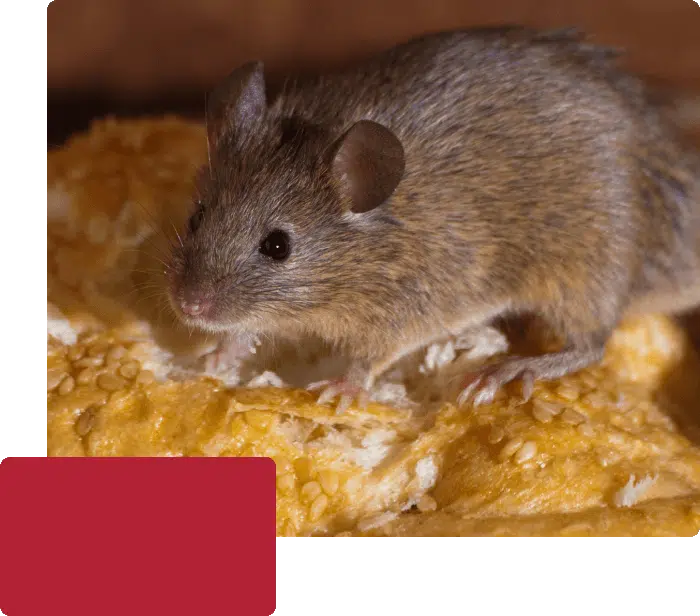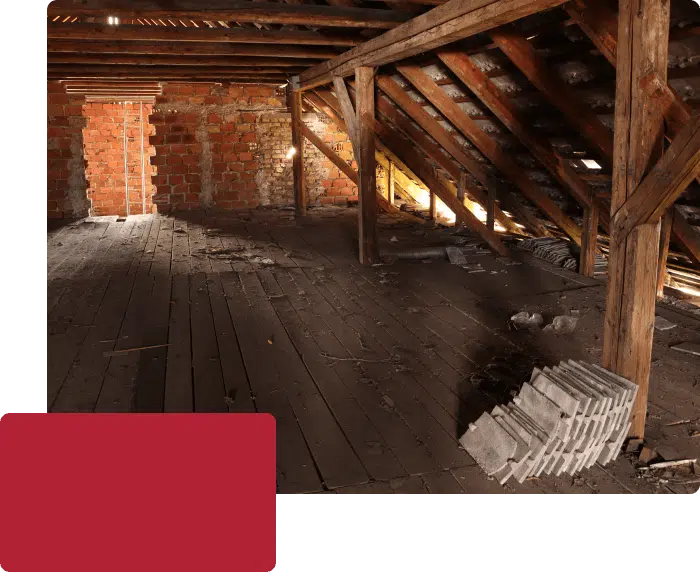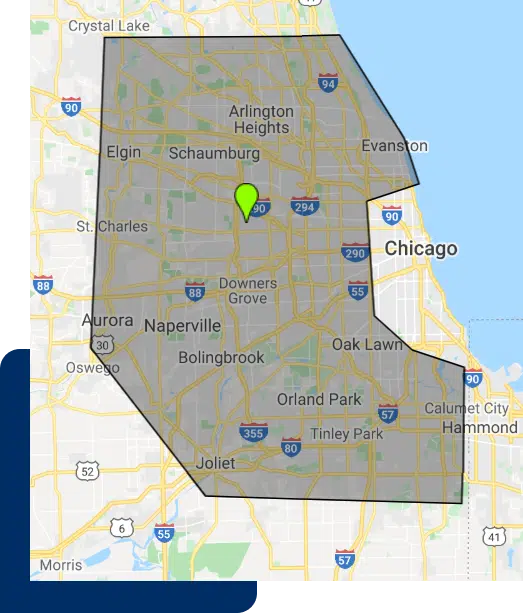Professional Mouse Exclusion Work in Chicagoland
Permanent Mouse Prevention Solutions
• Serving Chicago Area Since 1979

Mouse / Mice Exclusion Service
Want to end your mouse problem once and for all? Our Mice Exclusion Service is what you need to keep them out for good!

Catching mice is only half the solution. Without proper exclusion work, you're just playing an endless game of catch-and-release as more mice find their way in through the same entry points. AMPEST's professional exclusion work seals your home permanently, using materials and techniques that mice simply cannot defeat.
What Is Mouse Exclusion Work?
Mouse exclusion work is the process of permanently sealing all potential entry points to prevent mice from getting into your home in the first place. It's the difference between temporarily controlling a mouse problem and actually solving it.
The key difference:
- Trapping = temporary control (addresses mice already inside)
- Exclusion = permanent prevention (stops new mice from entering)
Think of it this way: if your boat has holes in it, you can bail water all day, but until you patch the holes, you'll never stop taking on water. Exclusion work patches the holes.
How Much Does Mouse Exclusion Work Cost?
Honest pricing ranges for Chicagoland homeowners:
Basic exclusion work: $200-$300
- Utility penetrations (most common entry points)
- Simple gaps where siding meets foundation
- Single bay window or similar feature
Moderate exclusion projects: $300-$1,000
- Multiple utility penetrations
- Siding work around portions of the home
- Several roof-level entry points
- Custom metal fabrication for unique features
Comprehensive exclusion work: $1,000-$2,000+
- Entire home perimeter treatment
- Multiple attic vents and fans requiring covers
- Complex roofline work with custom solutions
- Extensive metal work around foundation
What affects the cost:
- Number and complexity of entry points
- Accessibility of problem areas
- Materials required (basic sealants vs. custom metal fabrication)
- Height and roof complexity
- Special covers needed for vents and fans
Is Mouse Exclusion Work Worth the Investment?
The short answer: absolutely. Here's why every customer who's had exclusion work done agrees:
Financial perspective:
- One-time investment vs. ongoing mouse control costs
- Prevents property damage from chewing (including electrical wires)
- Eliminates health risks and cleanup costs
- Increases property value and marketability
Peace of mind perspective: After 45 years in business, we've never had a customer regret investing in proper exclusion work. The relief of knowing mice can't get back in is worth every penny to homeowners who've dealt with recurring problems.
Long-term effectiveness: Our exclusion work uses materials specifically designed to last years without deterioration. We don't use materials that rust, rot, or can be chewed through by mice.
Most Common Mouse Entry Points in Chicago-Area Homes
Based on thousands of inspections, here are the entry points we address most frequently:
1. Utility Penetrations (Most Common)
Air conditioning lines - The #1 entry point we see
- Gap between line and exterior wall
- Often inadequately sealed during installation
- Easy access point that mice exploit repeatedly
Electrical boxes and lines
- Gaps behind exterior electrical boxes
- Conduit entry points into homes
- Areas where electrical lines penetrate walls
Gas lines and water spigots
- Spaces around utility connections
- Often overlooked during home construction
- Require specialized sealing techniques
2. Foundation and Siding Issues
Where siding meets foundation
- Gaps that develop over time
- Corner areas particularly problematic
- Long stretches where siding has settled
Bay windows and box chimneys
- Framed structures without foundations underneath
- Hidden gaps that homeowners can't see
- Require mirrors and specialized access techniques
3. Garage Door Areas
Weather stripping failures
- Rubber seals that mice chew through
- Corner gaps where doors don't seal properly
- Access to interior through attached garages
4. Roof and Upper-Level Entry Points
Fascia board overlaps
- Gaps where fascia meets brick
- Mice climb brick walls to reach these openings
- Common problem in Chicago-area construction
Soffit problems
- Damaged or rotted soffit materials
- Gaps in soffit connections
- Ventilation areas without proper screening
Flashing issues
- Deteriorated flashing around rooflines
- Gaps where roof meets gutters
- Dormer and chimney flashing problems
Attic vents and fans
- Standard screens inadequate for mice (need quarter-inch mesh or smaller)
- Ridge vents without proper protection
- Attic fans with worn or missing screens
Professional Materials vs. DIY Attempts
What Makes AMPEST's Materials Different
Rodent Stop Caulk
- Contains metal fibers that mice cannot chew through
- Paintable and weather-resistant
- Specifically designed for pest exclusion
Excluder Steel Wool Products
- Rust-resistant steel wool that's cut to be pointy
- Mice won't even attempt to chew through it
- Professional-grade, not hardware store steel wool
Custom Metal Fabrication
- Galvanized metal bent to exact specifications
- Secured with tap-con screws directly into concrete
- L-shaped corners and custom configurations
Copper Mesh Products
- Won't rust like steel alternatives
- Perfect for smaller gaps and utility penetrations
- Professional-grade materials are difficult and costly to source residentially
Specialized Vent Covers
- Quarter-inch diamond mesh (essential for mice)
- Available in stainless steel, galvanized, or black powder-coated
- Different gauges for different pest exclusion needs
Why DIY Materials Fail
Standard caulk and foam
- Mice chew through these easily
- Not designed for pest exclusion
- Temporary fix that fails within months
Hardware store steel wool
- Rusts quickly in outdoor conditions
- Wrong type of cut (not designed to deter chewing)
- Falls out over time
Generic screening
- Mesh too large for mice (need quarter-inch or smaller)
- Not secured properly
- Doesn't address all potential entry points
Common DIY Exclusion Mistakes
1. Using Wrong Materials
The biggest mistake homeowners make is assuming any caulk or steel wool will work. Mice can chew through standard materials, making DIY attempts temporary at best.
2. Missing Critical Areas
Homeowners typically miss:
- Underside of bay windows and box chimneys
- Gaps behind electrical boxes (require digging to access properly)
- Roof-level entry points they can't safely reach
- Areas hidden by landscaping or deck structures
3. Not Being Thorough Enough
Finding 80% of entry points isn't good enough. Mice only need a quarter-inch gap, and they'll exploit any opening you miss.
4. Improper Installation Techniques
Professional techniques homeowners don't know:
- Digging down around electrical boxes to find true entry points
- Proper securing methods for different materials
- How to work in tight spaces with mirrors and specialized tools
- Understanding structural issues that create ongoing problems
AMPEST's Professional Exclusion Process
1. Comprehensive Inspection
Our technicians identify every potential entry point, including:
- Areas accessible only with mirrors and specialized tools
- Roof-level inspection (sometimes using drones for complex structures)
- Hidden areas behind landscaping and structures
- Structural problems that create ongoing vulnerabilities
2. Detailed Assessment and Proposal
We provide:
- Clear explanation of each entry point
- Recommended materials and techniques for each area
- Honest assessment of areas that may require reconstruction
- Prioritization of work based on risk level
3. Professional Installation
Our installation process:
- Use of professional-grade materials designed for pest exclusion
- Custom metal fabrication when needed
- Proper securing techniques for permanent results
- Documentation of all work performed
4. Quality Assurance
Every exclusion job includes:
- Final inspection to ensure all areas are properly sealed
- Customer walkthrough and explanation of work performed
- Documentation for warranty purposes
How Long Does Exclusion Work Last?
With proper materials and installation: years and years.
Our exclusion work uses materials that:
- Don't rust (stainless steel, galvanized, or coated materials)
- Can't be chewed (metal fibers in caulk, proper steel wool products)
- Don't deteriorate (weather-resistant, UV-stable materials)
AMPEST's Warranty Coverage
One-year guarantee on labor and materials for all areas we address:
- If mice get through our exclusion work within one year, we fix it at no charge
- Covers only areas specifically addressed in our work
- Some premium materials (like stainless steel) carry longer manufacturer warranties
What Could Require Additional Work
New openings from:
- Storm damage or structural settling
- Building modifications or additions
- Mice chewing through vulnerable areas we couldn't access initially
- Areas specifically noted as inaccessible in original proposal
Special Challenges: Older vs. Newer Chicago Homes
Older Home Complexities
Common issues:
- Multiple additions creating complex entry points
- Large front porches and low-lying decks limiting access
- Finished basements preventing interior access
- Some areas requiring reconstruction rather than exclusion
AMPEST's solutions:
- Custom metal fabrication for unique architectural features
- Honest assessment when reconstruction is more cost-effective
- Detailed documentation of inaccessible areas
- Phased approach for complex projects
Newer Home Challenges
Don't assume new means problem-free:
- Wooded lots with high natural mouse populations
- Flashing problems from construction shortcuts
- Utility penetrations inadequately sealed during building
Can Homeowners Do Their Own Exclusion Work?
Technically possible, but challenging for several reasons:
Accessibility Issues
Many entry points require:
- Ladder work on steep roofs
- Crawling under low decks or porches
- Working in tight spaces with specialized tools
- Professional equipment for safe access
Knowledge Requirements
Critical expertise includes:
- Understanding which materials actually work
- Knowing how to properly secure different materials
- Recognizing structural issues that create ongoing problems
- Understanding Chicago-area construction vulnerabilities
Time and Tool Investment
Professional exclusion requires:
- Specialized tools not typically owned by homeowners
- Time to properly inspect and address all entry points
- Physical ability to access difficult areas safely
- Knowledge of when to call in other trades (roofers, contractors)
When Exclusion Work Gets Complex
Situations Requiring Reconstruction
Sometimes exclusion work reveals bigger issues:
- Low-lying decks that prevent access to foundation areas
- Finished basements blocking access to entry points
- Structural problems that exclusion work can't address
AMPEST's approach:
- Honest assessment of what's required
- Recommendations for other trades when appropriate
- Phased approach when full reconstruction isn't immediately feasible
- Clear documentation of areas that remain vulnerable
Working with Other Contractors
We coordinate with:
- Roofers for flashing and structural roofing issues
- Contractors for deck or porch modifications
- HVAC technicians for utility line issues
Success Stories: When Others Couldn't Solve the Problem
The typical scenario we encounter: "[Large pest control company] has been coming here for five years. They put this little box in the corner and keep replacing the bait, but we still have mice everywhere."
Why other approaches fail:
- Focus on ongoing treatment rather than problem-solving
- No exclusion work or inspection for entry points
- Business model depends on recurring service calls
- Technicians not trained in proper exclusion techniques
AMPEST's results:
- Comprehensive inspection identifies real entry points
- Professional exclusion work addresses root causes
- Problem solved permanently, not managed indefinitely
- Customer satisfaction from actual problem resolution
Don't Let Mice Back In: The Value of Prevention
The reality: Without exclusion work, mouse control is just an expensive, ongoing subscription service.
The solution: Professional exclusion work that:
- Uses materials mice cannot defeat
- Addresses all entry points, not just the obvious ones
- Provides long-term protection with warranty coverage
- Eliminates the stress and health risks of recurring problems
Ready for Permanent Mouse Prevention?
Stop playing catch-and-release with mice. AMPEST's professional exclusion work provides the permanent solution your home needs.
Our exclusion work includes:
- Comprehensive inspection of all potential entry points
- Professional-grade materials designed specifically for pest exclusion
- Custom solutions for unique architectural challenges
- One-year warranty on all labor and materials
- 45+ years of experience solving Chicago-area mouse problems
Mouse Control & Exclusion Service
AMPEST solved the problem!
"We dealt with mice for FIVE YEARS. Our previous company would check their little basement bait box quarterly and tell us we were 'all set.' Three weeks later, scratching in the walls again.
AMPEST's technician spent over an hour on the inspection and found entry points we never knew existed - gaps behind our electrical box, under our bay window, garage door issues. The other company never even looked!
The exclusion work was well worth the investment, it's been eight months with zero mice. No more scratching, no more droppings, no more jumping on chairs. I wish we'd called AMPEST five years ago instead of wasting money on a company that just wanted to keep us as customers forever."
-Sarah M.
AMPEST made our new home Mouse Free....finally!
"Two weeks after buying our house in September, we had mice everywhere. Those loud attic noises we thought were squirrels? AMPEST confirmed they were definitely mice.
The inspection revealed gaps everywhere - A/C line, foundation areas, attic vents with screening too big to keep mice out. The builder did the bare minimum.
AMPEST's exclusion work included custom metal work, special vent covers, and that amazing caulk with metal fibers mice can't chew through. Six months later, still mouse-free and we can finally enjoy our new home."
-Mike and Jennifer K.
AMPEST - The Problem Solver!
AMPEST was the third company we tried. Mice every August like clockwork, and nothing lasted more than a few months.
Previous companies either just used poison or did basic caulking that missed the real problems. AMPEST found entry points others never looked for
-Robert D.
Ready to Solve Your Mouse Problem?
Mouse Exclusion is the answer you are looking for to eliminate your mouse problems once and for all. Put AMPEST's expertise to work for you today!

Our Service Area
If you are located in the "grey" area on the map then give us a call, we can help!
Not sure if you are in our service area or not? Call to find out.
